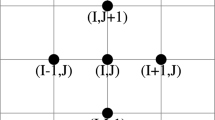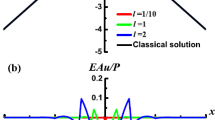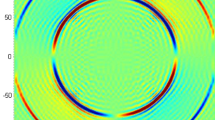Abstract
The peridynamic motion equation was investigated once again. The origin of incompatibility between boundary conditions and peridynamics was analyzed. In order to eliminate this incompatibility, we proposed a new peridynamic motion equation in which the effects of boundary traction and boundary displacement constraint were introduced. The new peridynamic motion equation is invariant under the transformations of rigid translation and rotation. Meanwhile, it also satisfies the requirements of total linear and angular momentum equilibrium. By this motion equation, three kinds of boundary value problems containing the displacement boundary condition, the traction boundary condition and mixed boundary condition are characterized in peridynamics. As examples, we calculated static tension and longitudinal vibration of a finite rod. The acquired solutions exhibit obvious nonlocal features, and the vibration has the dispersion similar to one dimensional atom chain vibration.





Similar content being viewed by others
References
Silling, S.A.: Reformulation of elasticity theory for discontinuities and long-range forces. J. Mech. Phys. Solids 48, 175–209 (2000)
Silling, S.A., Epton, M., Weckner, O., et al.: Peridynamic states and constitutive modeling. J. Elast. 88, 151–184 (2007)
Silling, S.A., Lehoucq, R.B.: Peridynamic theory of solid mechanics. Adv. Appl. Mech. 44, 73–168 (2010)
Madenci, E., Oterkus, E.: Peridynamic Theory and Its Applications. Springer, New York (2014)
Bobaru, F., Foster, J.T., Geubelle, P.H., et al.: Handbook of Peridynamic Modeling. CRC Press, New York (2017)
Javili, A., Morasata, R., Oterkus, E., et al.: Peridynamics review. Mech. Math. Solids. https://doi.org/10.1177/1081286518803411 (2018)
Emmrich, E., Weckner, O.: On the well-posedness of the linear peridynamic model and its convergence towards the Navier equation of linear elasticity. Commun. Math. Sci. 5, 851–864 (2007)
Silling, S.A., Lehoucq, R.B.: Convergence of peridynamics to classical elasticity theory. J. Elast. 93, 13C–37 (2008)
Bobaru, F., Hu, W.: The meaning, selection, and use of the peridynamic horizon and its relation to crack branching in brittle materials. Int. J. Fract. 176, 215–222 (2012)
Bazant, Z.P., Luo, W., Chau, V.T., et al.: Wave dispersion and basic concepts of peridynamics compared to classical nonlocal damage models. J. Appl. Mech. 83, 111004 (2016)
Butt, S.N., Timothy, J.J., Meschke, G.: Wave dispersion and propagation in state-based peridynamics. Comput. Mech. 60, 725–738 (2017). https://doi.org/10.1007/s00466-017-1439-7
Silling, S.A., Zimmermann, M., Abeyaratne, R.: Deformation of a peridynamic bar. J. Elast. 73, 173–190 (2003)
Weckner, O., Abeyaratne, R.: The effect of long-range forces on the dynamics of a bar. J. Mech. Phys. Solids 53, 705–728 (2005)
Weckner, O., Brunk, G., Epton, M.A., et al.: Green’s functions in non-local three-dimensional linear elasticity. Proc. R. Soc. A 465, 3463–3487 (2009)
Mikata, Y.: Analytical solutions of peristatic and peridynamic problems for a 1d infinite rod. Int. J. Solids Struct. 49, 2887–2897 (2012)
Wang, L.J., Xu, J.F., Wang, J.X.: Static and dynamic greens functions in peridynamics. J. Elast. 126, 95–125 (2017)
Di Paola, M., Failla, G., Zingales, M.: Physically-based approach to the mechanics of strong nonlocal elasticity theory. J. Elast. 97, 103–130 (2009)
Di Paola, M., Pirrotta, A., Zingales, M.: Mechanically-based approach to nonlocal elasticity theory: variational principles. Int. J. Solids Struct. 49, 539–548 (2010)
Huang, Z.: Nonlocal effects of longitudinal vibration in nanorod with internal long-range interactions. Int. J. Solids Struct. 49, 2150–2154 (2012)
Huang, Z.: The damage models based on the representation of nonlocal residual. Math. Mech. Solids 17, 317–326 (2012)
Seleson, P., Parks, M.L.: On the role of the influence function in the peridynamic theory. Int. J. Multiscale Comput. Eng. 9, 689–706 (2011)
Acknowledgements
This work was supported by the National Natural Science Foundation of China (Grant 11672129) and the Research Fund of State Key Laboratory of Mechanics and Control of Mechanical Structures (Nanjing University of Aeronautics and Astronautics, MCMS-I-0218G01). The author thanks Professor Dan Huang and Dr. Fei Han for their valuable comments.
Author information
Authors and Affiliations
Corresponding author
Appendices
Appendix A
With Eq. (11), we have
where \(\mathbf y (\mathbf x ,t)=\mathbf x +\mathbf u (\mathbf x ,t)\). Integrating Eq. (A1) over \(\Omega \) leads to
In Eq. (A2), the first term can be rewritten as
Owing to Eq. (14) or (16), Eq. (A3) reduces to
With Eq. (2), it is easy to give that [2]
In terms of Eq. (15) or (17), Eq. (A5) reduces to
Substituting Eqs. (A4) and (A6) into Eq. (A2) yields
which shows that the equilibrium of angular momentum is satisfied for a bounded body subjected to boundary traction, boundary displacement constraint and body force.
Appendix B
With Eq. (36), Eq. (33) is written as
Let
so we have
That is
Rights and permissions
About this article
Cite this article
Huang, Z. Revisiting the peridynamic motion equation due to characterization of boundary conditions. Acta Mech. Sin. 35, 972–980 (2019). https://doi.org/10.1007/s10409-019-00860-3
Received:
Revised:
Accepted:
Published:
Issue Date:
DOI: https://doi.org/10.1007/s10409-019-00860-3




